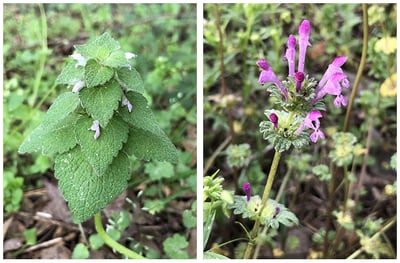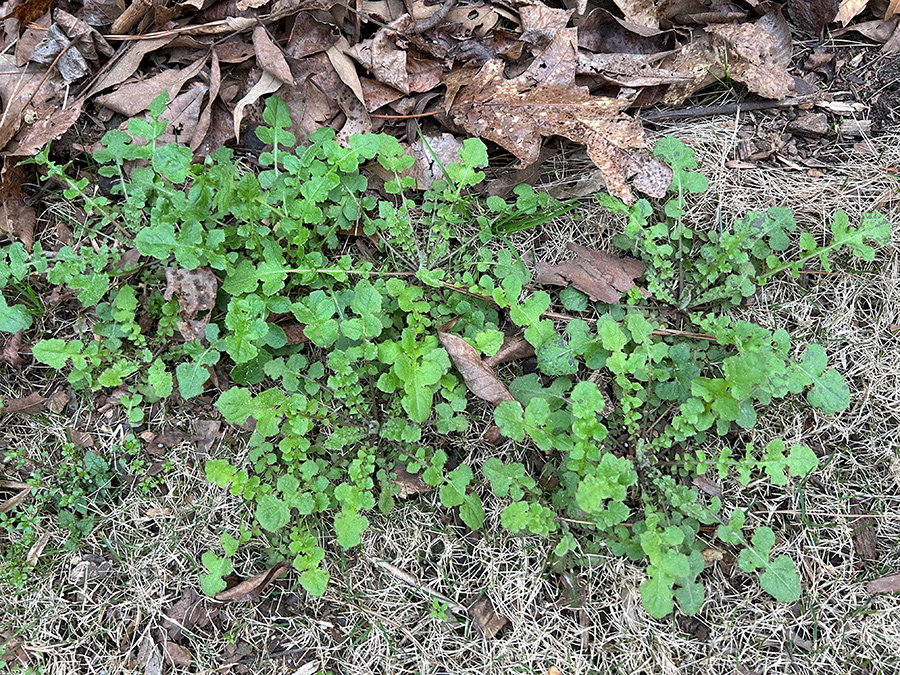

Our lawn weed of the month will be the twin Youngia weeds, Youngia japonica (Oriental false hawksbeard) and Youngia thunbergiana (tall false hawksbeard) because they become more noticeable during the warm days of April and May when they are flowering. If you’re like me and like to look closely at the ground, you’ll start to notice the basal rosettes on this biennial plant throughout the year. We'll cover how to identify and control them.
The two Youngias are called “false” hawksbeard because their leaves look a lot like smooth hawksbeard (Crepis capillaris) but their flowers are much smaller. Youngia japonica used to be called Crepis japonica, but they reclassified it.
To add to the confusion, Youngia thunbergiana was give its own handle in 2013 when it was removed from the Youngia japonica line and became its own species. The main difference is the flower head structure (see under ID features), but the leaves are so similar that for purposes of control in lawns I’m going to call them “Youngia” in this weed profile.
Regardless of the confusing nomenclature, please learn to identify this invasive weed and don’t let it go to flower and thus go wild all around your property.
False Hawksbeard ID Features
To control false hawksbeard, we first need to learn how to identify it.
- Family: Asteraceae, commonly known as the aster, daisy, or sunflower family
- Habit: Basal rosette of leaves with erect flower stems; those flower stems are hollow and hairy
- Roots: Short, weak taproot
- Leaves: Green, oblanceolate to spatulate basal leaves, with irregularly toothed margins; stem leaves are smaller and sessile; basal leaves resemble dandelion and smooth hawksbeard
- Flowers: Not showy, tiny, yellow, dandelion-like flowers. On Youngia japonica the flowers are borne on branched, loose stalks at the ends of the hollow flower stems; on Youngia thunbergiana they are in clusters at the ends of stems. There is diversity in the flower heads in my lawn which makes me think I have both Youngias to fend off. Either way, eradication methods are the same.
- Fruit/seed: Small, flattened, brown to black seeds with white, feathery pappus for wind dispersal (like wee dandelion puffs)
Youngia colony in February. This weed has been inconspicuous until February, when it warms up just enough to start bulking up.
Youngia in April when it's gotten huge and is flowering.
Close up of flowers on Youngia thunbergiana (I think).
Flowers on Youngia thungerbiana (left) and Y. japonica (right), best I can determine. Both types are in my yard and have similar leaves but clearly different flower structures.
Youngia going to seed.
Youngia is a biennial weed native to East Asia, but it has found its way to other parts of the world, including the United States where it’s become invasive from zones 5 to 8.
It’s invasive because of the copious amounts of wind-borne seeds produced by just one plant. Plus, it’s happy in various conditions from full sun to partial shade and is adaptable to well-drained or moist soils, so it has a lot of options.
Because it thrives in disturbed soils of new construction, it’s become a common nuisance for homeowners and gardeners. You will also see it along roadsides and in fields in agricultural settings.
Eat It or Treat It - How to Control False Hawksbeard
Youngia is edible, with its young leaves and stems consumed raw in salads or cooked in various dishes. This came as a surprise, though it shouldn’t because so many lawn weeds have turned out to be edible such as bittercress, chickweed, and violets.
It’s described as having many medicinal properties and I don’t find it on any animal toxicity lists. I have never seen a bee or butterfly on the Youngia invading my property, even though it’s reported as being a pollinator plant. This afternoon I noticed that a stand of Youngia on the woodland edge had all the flower/seed heads chewed off, thus the deer were doing my job in keeping the seeds at bay.
Weighing the benefits versus the invading tendencies, the choice is yours whether you eat it or treat it. I may do both until it’s eradicated from my lawn.
Youngia Weed Prevention
- Pre-emergent herbicide: Youngia are biennials that spread by seed so the April pre-emergent application should be effective in preventing more plants from colonizing your lawn.
- Prevent Youngia in flower beds with thick layers of mulch and by spreading pre-emergent there too, if you don’t plan on planting any flowers or vegetables from seed.
- Maintain a healthy, dense lawn to prevent the establishment of Youngia. Proper mowing, watering, and fertilization practices will help create a strong turf that can outcompete this weed. Also, avoid overwatering, as that can encourage weed growth.
- If bald spots develop in your lawn, correct the underlying problem, and get individual rolls of sod to cover those bare spots before more weeds germinate there.
Manual Removal of Youngia
- Hand-pulling is effective for small infestations, especially when the soil is moist. They are very easy to pull up unless the tap root is really stuck in there good in dry or compacted soil. You can often yank it up by the hollow stem, but sometimes those hollow stems quickly snap off, so you’ll have to grab it by the basal rosette to pull it out, roots and all.
- If it appears in your lawn, simply mowing it (so it doesn’t go to flower and seed) will do a lot to control the spread.
Chemical Control of Youngia
- Post-emergent herbicide: We recommend any product with 2,4-D as the active ingredient. Spray them when they are young and you'll use less chemicals. We sell broadleaf herbicide for weed control in our online store.
- Apply according to the product label and target young plants for the best results. Always follow safety guidelines when using chemical treatments.
Learn more about Youngia from these websites:
- NC State Extension Service
- North Carolina Botanical Garden
- UGA Extension Service
- Tennessee-Kentucky Plant Atlas
- Weed Science Society of America
Questions? Leave a comment below.
If you're a weed aficionado like me, check back here for future Weeds of the Month. Until then, happy weeding!
All pictures by Hillary Thompson.





